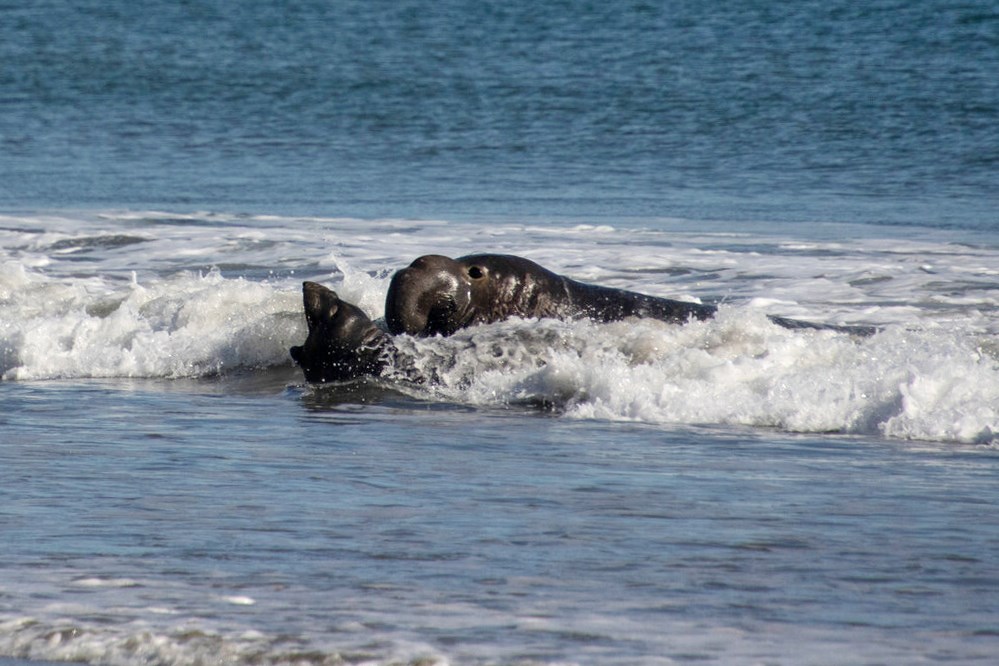Last updated: October 10, 2024
Article
Scientists Describe Surprising New Male Elephant Seal Behavior

NPS / PRNSA / Aiko Goldston - NMFS Permit No. 21425
March 2024 - A bull elephant seal fighting a bloody battle with another bull over breeding rights? Sounds about right. Raising his huge head and trumpeting for all to hear? Absolutely. Running over a pup while chasing a female into the surf to mate with her? It happens. Snoozing on the beach for long stretches? Yup—he is fasting after all. Charging into the surf to rescue a drowning pup? That’s absurd! Or is it…?
When they come ashore to breed each winter, male northern elephant seals usually show off a predictable, mating-focused behavioral repertoire. Heroic or even helpful acts are basically not in there. Helping others is quite rare among male marine mammals in general. So Marine Ecologist Dr. Sarah Allen and Wildlife Biologist Matt Lau could hardly believe their eyes as they watched a bull rescue a pup on January 27, 2022, at Point Reyes National Seashore. This winter, they and Marine Ecologist Sarah Codde published the unusual observation in Marine Mammal Science, and had it picked up by The New York Times, Nature, and other outlets.

NPS / Matt Lau - NMFS Permit No. 21425
For Allen and Lau, the drama unfolded during a routine elephant seal survey on Drakes Beach as the tide was coming in. A female elephant seal and her young pup caught their attention. The female was at the water’s edge, urgently calling to the pup, which was being pulled out to sea by waves, unable to swim. The alpha male elephant seal presiding over the small group of nearly 40 females on that stretch of beach was about 30 feet away from the distressed female. As Allen and Lau watched, he approached the female, touched his nose to her side, and then charged into the water towards the struggling pup about 130 feet out. Upon reaching the pup, the alpha male used his head and body to gently nudge it towards shore and protect it from the pull of the undertow. Almost 20 minutes later, mom and pup were reunited and on their way to higher ground. The female called out in a voice reserved for interactions with males. Seconds later, the male, still at the edge of the waves, trumpeted.
Allen has studied elephant seals for several decades. Lau has surveyed them across Point Reyes for several seasons. Neither had seen a male do anything like that before, yet they know their eyes didn’t fool them. Lau captured the whole sequence of events in an incredible series of photographs, which is included in the published account.
Allen, Lau, and Codde argue that the male’s behavior was altruistic—that he sacrificed some of his own wellbeing to benefit the pup. After all, 20 minutes of time and energy for a pup rescue right in the middle of his 3-4 month fast (elephant seals don’t eat when they’re on shore to pup, breed, or molt) is not nothing! That’s energy he could have saved to defend his access to females, or to mate with them. There also could have been costs to leaving his hard-won female group vulnerable to competing males for that time.

NPS / Matt Lau - NMFS Permit No. 21425
So what would explain the male’s potentially altruistic act? Only he knows his reasons, but the scientists do propose some possibilities. For example, he may have been closely related to the pup. Aiding kin is a common explanation for altruism in animals. Or the male may have had more energy to spare than most due to the uncrowded—maybe less competitive—nature of the still-new Drakes Bay elephant seal colony in 2022.
In any case, the trio of scientists hope their observation will prompt a closer look at male elephant seal behavior. Documenting any repeat grand gestures could one day help unlock the secrets of altruism’s origins. Or maybe we’ll learn that males regularly do smaller things that no one recognized before as potentially altruistic. There could be more to these mighty beach bulls than meets the eye!
For more information
- Allen, S. G., Lau, M. J., & Codde, S. A. (2024). An observation of potential altruism by a male northern elephant seal (Mirounga angustirostris). Marine Mammal Science, 1–6. https://doi.org/10.1111/mms.13105
- San Francisco Bay Area Network Pinniped Monitoring webpage
- Point Reyes’ Viewing Elephant Seals webpage
- Pacific Coast Science & Learning Center Elephant Seals webpage
- Contact Marine Ecologist Sarah Allen at sallen520@gmail.com
